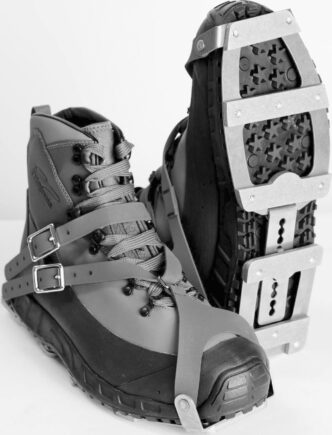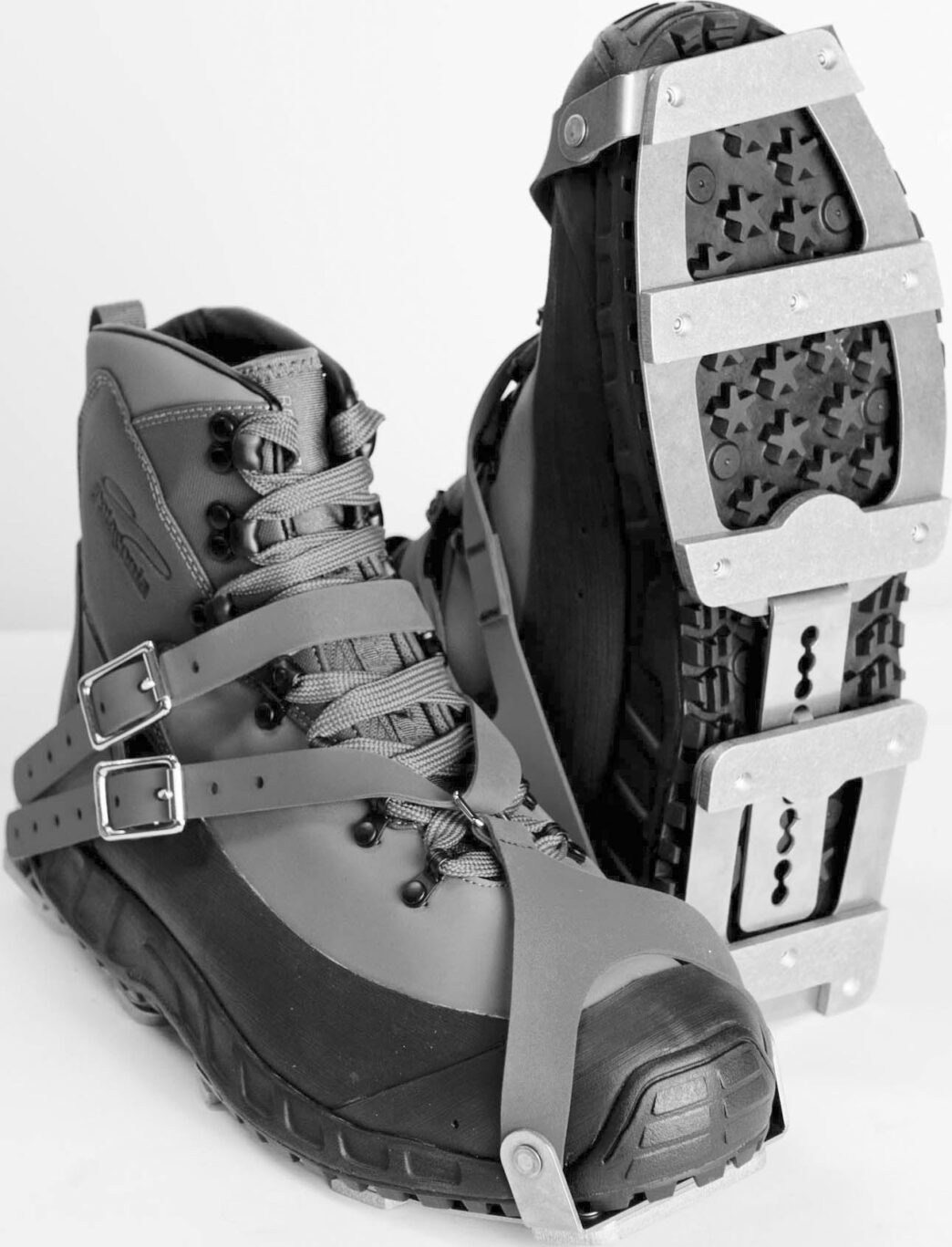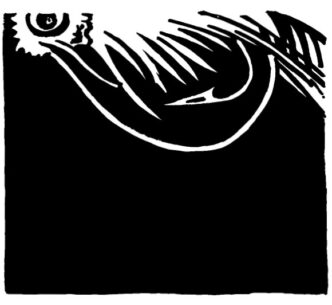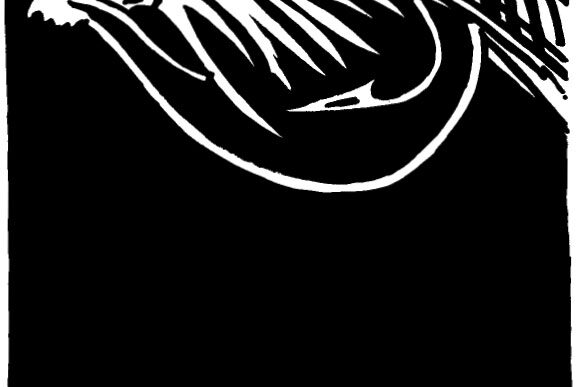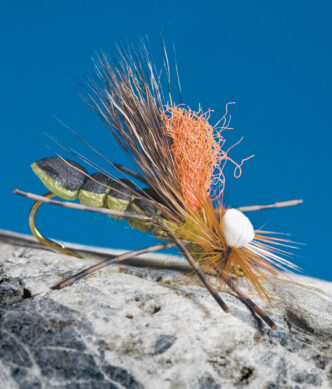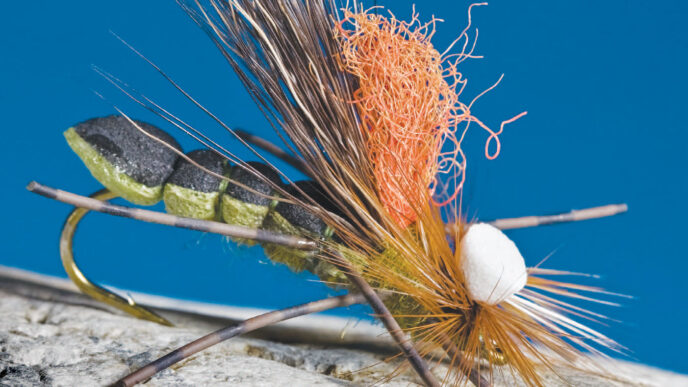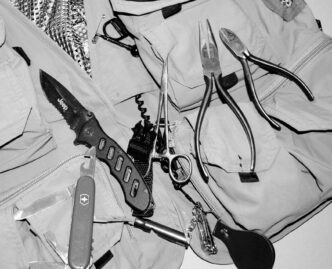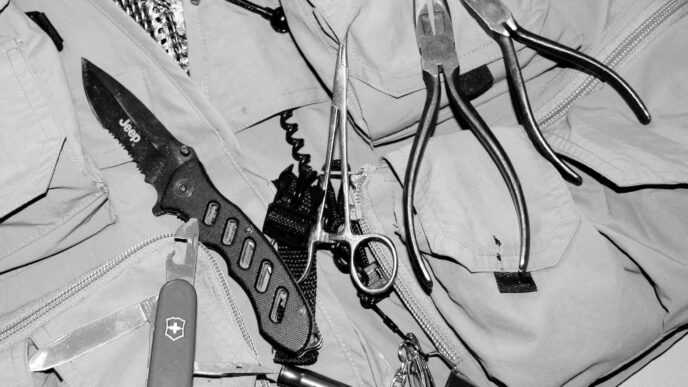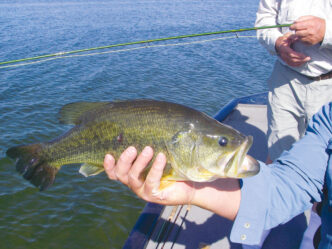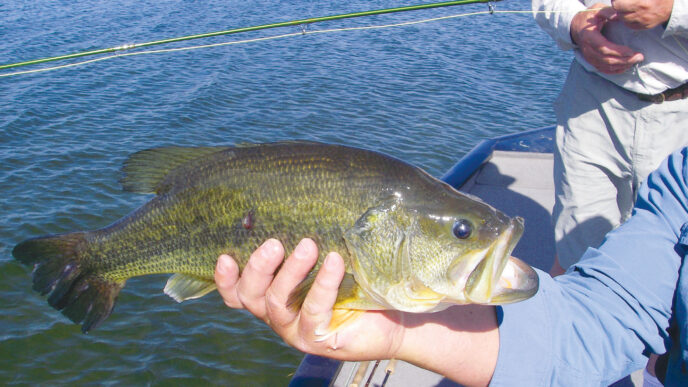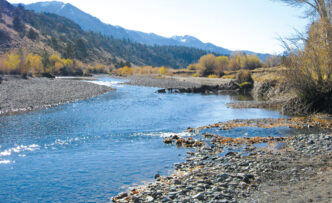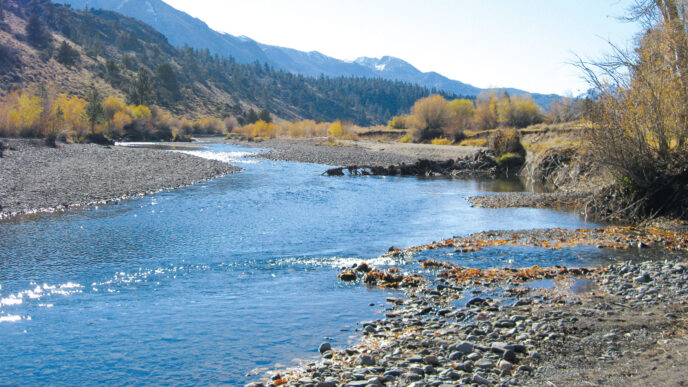As I write this, I hope it’s premature to complain about the driest winter in decades and what that means for our already shaky runs of steelhead and salmon. But if we continue to stay dry, spring fishing ought to be terrific, so let’s think optimistically and take a look at some interesting new gear that should make our angling more enjoyable.
Staying Upright
The push toward wading boots with soles that are less friendly to hitchhiking invasive species got a lot of press, but apparently earned only grudging acceptance from anglers. Why? The various sticky rubber soles work, sorta, but not as well as felt soles, and nowhere nearly as well as felt with studs. Moreover, to really get a grip with any sticky rubber, you need to add cleats. But what kind of cleats, how many, and where do you place them on the boot? What’s more, if you already have felt-soled boots, fish only one stream, and thus aren’t bringing in anything that isn’t already there, why bother? I suspect that this last bit of reasoning was why Simms, who for the past couple of years has enthusiastically waved the sticky-rubber / no-invasive-hitchhikers banner, decided to keep offering its felt-soled boots.
Last year, Simms introduced star-shaped AlumiBite cleats ($29.95), in addition to the two kinds of tungsten studs they already offered for their sticky-rubber-soled boots. If you’ve ever paddled an aluminum canoe or rowed an aluminum drift boat on a rocky stream, you know why that was a good idea. Aluminum is soft and malleable enough to grab rocks, but when added to a boot sole has the hardness to cut through most of kinds of scum. AlumiBites are shaped to fit the Simms StreamTread outsole and work pretty well. Most of the guys I know who use them still combine them with one of Simms’s other cleats on the same boot, on the theory that if one cleat doesn’t stick, another kind will. That’s effective, but shelling out a total of $60 or $70 on top of the price of a pair of boots puts me in Scrooge mode.
Patagonia has just introduced another wading-sole option with two new products that have outsoles of soft aluminum bars. This was something tried, I think successfully, by Dan Bailey twenty years ago with Super Stream Kleats, now discontinued. The new Patagonia River Crampons ($199) have their roots in the ice crampons that Patagonia’s founder forged in the company’s early days, and you strap them to the soles of your wading boots. The River Crampons have bars of soft aluminum riveted to a lightweight stainless-steel frame that can be adjusted for boot size. Three bars go across the width of the foot, and two go across the heel. There’s a lot of aluminum to provide a very sticky surface, and the ladderlike bars also provide a lug-like effect for traction on snotty mud or clay.
Patagonia’s Rock Grip Aluminum Bar Boots ($239) have the same size, number, and placement of soft aluminum bars as the River Crampons, but rather than being riveted to a perimeter frame, the bars are screwed to the rubber outsole of Patagonia’s updated Rock Grip boot (available in studded sticky rubber for $179). Bars on the boots are replaceable by the owner if they wear down, while the riveted bars on the River Crampons must be sent back to Patagonia for replacement. Initial reports from field testers such as Craig Matthews of Blue Ribbon Flies suggest that these cleats not only stick to the bottom like grim death, but are comfortable when walking and wading. They are a winner, and I’ll be buying a pair of River Crampons for the spring.
Wading anglers don’t stay on their feet solely (to use a bad pun) by virtue of what’s on the bottom of their boots. Even if you’re young and immortal, a wading staff is a smart thing to carry on all but the mildest rivers. You can make do with a piece of tree limb that you find next to the water, but they’re never quite the right length, or straight enough, or strong enough to hold your weight, and if they are, the diameter is frequently too large or knotty to grasp comfortably. An aluminum ski pole or hiking staff will work, but the metal-to-rock noise they make whacking along the bottom seems counterintuitive to a stealthy approach. There are some decent collapsible staffs, including those by Folstaff, Simms, and Fish Pond, and collapsible wading staffs are a godsend when you need to stuff one in a duffel bag. They’re metal, of course, and many of them also vibrate considerably in heavy flows, which is off-putting. The Folstaff I’ve used for decades is handy when not in use, easy to assemble, but it’s a circus show when breaking it back down and stuffing it back in its holster.
If a stealthy approach is your game and you don’t mind carrying a long staff, then you want something that’s easy to grasp, is stiff enough not to vibrate, and makes less noise whacking the rocks than metal. The Pit River Wading Staff, a new offering, is 48 inches of straight-grained white ash painted a flat forest green, with a T-grip handle and a rubber tip. The T-grip handle, a shape popular with canoeists, offers a comfortable, secure grip and is also useful for unsnagging flies from trees. The staff is marked with a 30-inch ruler, has an attached cord with a carabiner to snap to your belt or vest, and is offered in both a floating version and a sinking version that’s tip-weighted with a short oversleeve of copper tubing. Either version costs $60 at your local fly shop.
New Waders for 2012
Simms has added a new Guide model to its made-in-Bozeman Gore-Tex wader lineup. The principal difference between the new Guide and the company’s existing G3 Guide model, apart from a $50 price difference ($399.95 versus $449.95) seems to be the lack of a chest pocket and only three-layer construction, with reinforced front leg panels in the Guide, instead of the G3 Guide’s five layers in the seat and legs.
There’s also a redesigned Simms Freestone stocking-foot wader made from an improved QuadraLam fabric, with center seam construction, articulated knees, and a bunch of other features common to the company’s U.S.-made Gore-Tex models. With 15 stock sizes and a $229.95 price, you may be hard pressed not to consider the Freestone when looking at new waders. They’re easily converted to waist-highs, but you can buy a new waist-high Freestone version for $199.95.
L. L. Bean has two new waders, including a Rapid River boot-foot model ($379 to $419) that uses the BOA turn-dial lace-tightening system with a slick new attached boot. Soles are AquaStealth sticky rubber in either plain or studded versions. Bean has also improved their Helix stocking-foot waders, the ones where one continuous seam runs around the legs to minimize seam wear. For 2012, you get a more breathable torso, better and bigger pockets, and reinforced areas on the front to which you can attach things such as zingers ($299 to $319).
Finally, Patagonia has entered the lightweight, packable wader market in a big way with their new Rio Azul stockingfoot models, made from a new four-layer fabric in which the fourth layer provides a hydrophilic barrier to capture and distribute moisture. Rio Azuls are Patagonia’s lightest waders ever, have a waterproof interior pocket, left-foot and right-foot shaped booties and legs, adjustable suspenders, a built-in wader belt and gravel guards, and a utility keeper tab on the front. They’re $239.
Stay Dry Above
What’s there to be said about angling rain jackets, particularly in a dry year? Well, they’re generally made from one breathable fabric or another, and they’re a great outer layer when it’s windy and cold. Beyond that, they all have big front pockets for fly boxes and generally have additional smaller pockets. Most close with some sort of windproof/waterproof or water-resistant zipper and have cuffs that keep water from creeping up past your wrists. And dry year or not, some interesting new jackets are now available from fly shops.
Sage’s new Quest ultralight wading jacket weighs only 10.5 ounces, so it’s not only easy on your shoulders, but packs down to a very tidy bundle. Sleeves are articulated for ease of movement, there are a couple of zipper-closed pockets, a laser welded accessory port, and an adjustable waist. It’s a clean look. And my hat’s off to the folks who decided to price it at a flat $200 instead of $199.95.
Simms’s new ProDry Gore-Tex Jacket was a winner at both the conventional tackle industry’s ICAST show and the Fly Fishing Retailer Show. I get the feeling that when they designed this jacket, Simms, looking to expand their reach beyond us simple fly folk, was thinking, about the guys who fish bass tournaments and race around in metal flake-colored boats in all sorts of weather. In any event, the ProDry jacket is cut long enough to fall just below the hips, and Simms guarantees that it’s going to keep you dry in extreme conditions — which is to say 22 inches of rain per hour. That’s not exactly fishing weather, but the protection is something you might be happy with if you’re running a skiff into rain and spray at 40 miles an hour somewhere offshore or in the Delta. There’s stretch fabric in the elbows and shoulders for freedom of movement, along with big chest pockets and zippered handwarmer pockets lined with microfleece that have built-in heatpack pockets. The hood is stowable, the front zipper is waterproof, and the cuffs are waterproof and adjustable. It’s a really slick piece of outerwear, priced at $499.95. If you don’t need a jacket in fury orange so the rescue chopper can find you, you can choose steel gray or Delta green. ProDry bibs ($399.95) and pants ($299.95) are also available.
L. L. Bean’s new Gore-Tex Pro Shell Stretch Wading Jacket ($379 to $399) uses Gore-Tex’s premium fabric and has a hood that stows in the collar when not in use. It also has built-in stretch in the raglan sleeves to provide freedom of movement, which is a nice touch. There’s both an inner neoprene cuff and an outer cuff with hook-and-loop closures, and the cut of the jacket is just a bit longer, which makes the jacket useful when not wading . . . as in when fishing from boats or just walking around town.
For 2012, Redington applied their ultrasonic seam-welding technology, introduced last year with the company’s SonicPro waders, to a new wading jacket. Welding seams ultrasonically not only makes for less bulk than stitching and/or taping, but is also extremely durable. The new SonicPro Wading Jacket ($299.95) has all the expected features, including a waterproof front zipper, attached hood, and rubber gasket cuffs.
Another Fly Reel
November’s section on new fly reels missed mentioning the Bauer MacKenzie CFX ($310 to $445). Bauer is the company that, back in the early 1990s, first put a disc drag on a large arbor reel. The new MacKenzie CFX has the retro look of the original MacKenzie, but uses the sealed, silky-smooth, floating carbon-fiber disc drag of the company’s recent Rogue models. The frame and spool are both attractively ported, and the detented star drag knob stays with the spool when it’s removed, so there are no lost parts. The spool and drag system rotate on sealed, precision stainless-steel ball bearings, and the noncorrosive, patented Bauer zero backlash clutch makes for easy lefthand–right-hand conversion without tools. It’s available in five sizes for line weights 3 through 9, as well as in two new Spey models intended for switch rods and two-handed rods.
Bauer also introduced a new Rogue Classic model ($545 to $665), designed with switch, Spey, and heavier saltwater rods in mind. It has the same drag as the standard Rogue and the new CFX, which is to say sealed, carbon fiber, easy to maintain, and very smooth. The spool is ported, but the frame has a solid back to help provide the mass to balance bigger rods. It’s available in 4-inch, 4.25-inch, and 4.5-inch diameters suitable for Spey lines from 6-weight to 11-weight and a healthy length of backing — classic indeed.

New Trout Lines
New fly lines seem to emerge at about the same rate as Kardashian sightings, but it would take more space than the editor allots me to mention all of them. The lines, that is. Let’s just look at some new trout tapers.
For the ultralight-line junkies among us, RIO has expanded its presentation-oriented LT line offerings to include double taper 0-weight, 00-weight, and 000-weight lines. The 0-weight line weighs only 54 grains for the first 30 feet, the 00weight is 48 grains, and the 000-weight is 42 grains. That’s about half the weight over the same length as a 3-weight line. RIO lists the tensile strength of the 0weight, 00-weight, and 000-weight lines at 15 pounds, which should be ample for any trout fishing, and I’m guessing the belly diameters are in the .029-inch range, with a long taper to .026 inches or so. Up until now, only Sage has offered such lines — in their Quiet Taper lineup — which not so coincidentally mate with Sage’s TXL series of very light-line fly rods. But the Quiet Taper line has apparently been quietly discontinued, so it’s unsurprising that sister company RIO (both Sage and RIO are part of Far Bank Enterprises) has picked up the burden, which in this case is very light indeed.
Scientific Anglers made a big splash with Sharkskin a handful of years ago. While most folks praised its performance, some complained about the sound the line makes passing through the guides or were bothered by its tendency to abrade a groove in one’s stripping finger when retrieving. There was that $99.95 price, too. The answer was Mastery Textured, announced in 2010, a line with benefits similar to Sharkskin, but with a gentler surface and a $79.95 price. For 2012, SA has introduced the Mastery Textured Trout Stalker, a bit of a mouthful, but what appears to be a very nice all-around trout line. The dimpled surface shoots well and has reduced memory. The belly is long for delicacy, and the tapered six-foot tip section has the proprietary technology for better floatation that SA calls Dry Tip and ends in a streamlined loop. Lines are printed (get out your reading glasses) with weight and line type. It’s available in line weights 3 through 7 as weight-forward floaters.
Not to be outdone, Orvis is offering a new Hydros 3D trout line for 4-weight through 6-weight rods. This is another line with what Orvis describes as a “microtextured” surface, the benefits of which are easier shooting and, because the line floats higher, easier pickup off the water. Orvis also claims that the new surface coating significantly improves durability. Revised tapers include a tip section that makes use of methane/butane micro balloons for better tip floatation and tip diameters that have been ever so slightly increased (.001 inches to .005 inches, depending on line weight) to increase floatation further without sacrificing delicacy. Tip loops are Orvis’s new slim, low-profile version that slices one side of the loop on a bias and adds a knurled surface to the other side to increase the surface area of the weld for better strength. The lines are olive dun in color and are printed with weight and line type, requiring only magnifying glasses to decipher, though that’s still better than marking the line with a felt pen or putting a sticker on your reel. And in what I think is a really nice touch, Hydros 3D lines are packaged on spools and in boxes of recycled paper that are biodegradable. They’re priced at $89.
Cortland’s new Competition Nymph line ($75) isn’t a conventional floating line or even one you’d use to cast traditionally or with a big indicator. Rather, it’s a specialty taper designed for short-cast high-sticking or European-style nymphing. (Take your pick: Czech, Polish, French, Spanish, whatever.) The ultrathin, limp, long front taper and very thin tip are built that way in order to “drape” better over the tip top when leading a fly down a run. The extremely long, fine tip is also said to make a long mono butt section on your leader unnecessary. The line is offered in two sizes: 140 grains at 45 feet to match 9-foot to 11-foot fine-tipped nymphing rods that are nominally rated for 2-weight or 3weight lines and a slightly heavier 150grain line at 45 feet to match 4-weight or 5-weight nymph rods.
That’s it until May, when with any luck, we’ll have already had some great trout fishing.



